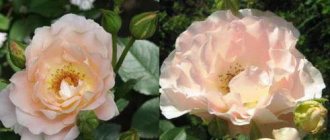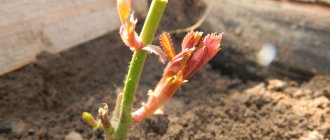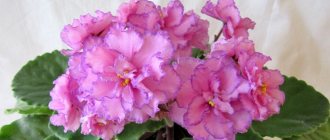History of selection
The history of breeding the Aloha variety goes back decades. The first version of the hybrid was released in 1949. Its appearance occurred thanks to American gardeners. In Europe, roses from the USA are not popular - a local analogue was bred in Germany.
The preparation of the plant and the development of hybrids of the new Aloha were carried out by a popular company specializing in the selection and production of roses - Wilhelm Cordes and Sons. The result was ready by 2003 - Aloha was registered as a new variety. In the official list the variety has several names:
- Aloha;
- Kordes Rose Aloha;
- Aloha Hawaii;
- Korwesrug.
Both varieties, bred in 1949 and 2003, belong to climbers - roses with large inflorescences, tough shoots and repeated flowering throughout the warm season. The main difference between the two hybrids is the color and shape of the bud. The old version of Aloha has delicate pink petals and a cupped or rounded outline.
Landing
The climbing rose "Aloha" is great for planting in open ground, but you should avoid windy areas. Gusts of strong wind and drafts are one of the reasons for the lack of flowers in this variety. Due to its large size, the Aloha rose is tree-like and therefore requires more fertilizer. Planting in the ground is carried out strictly, adhering to the following rules:
if the Aloha rose is planted in the spring, you must wait until the soil warms up to +10ºС; the planting area should be well lit, but partial shade is also allowed; if you plan to plant near a building, then you need to choose a place so that running rainwater does not fall on the bush; a few days before planting, the plant cuttings must be kept in a growth-stimulating solution; a hole must be at least 40 cm deep, at the bottom of which there must be a drainage layer of fine gravel; the next layer is organic fertilizer (at least 10 cm), and then soil again; It is recommended to maintain an interval of 1 meter between bushes to stimulate the growth of green mass and the setting of young buds; the cutting must be placed evenly in the hole and carefully tamped down as it is sprinkled with soil; there should be no cavities among the roots; To prevent the seedling from disappearing, the root collar of the plant should be 3 cm above the ground level; The bush must be watered generously and sprinkled around with a small layer of peat to retain moisture in the soil
You can propagate the Aloha rose yourself by rooting a climbing layer in mid-spring or early autumn.
The "Aloha" variety is a rather unpretentious plant. It is worth performing such basic care measures as:
- weed control;
- regular but shallow loosening of the soil;
- fertilizing the plant (depending on the season: in the summer - potassium and phosphorus, and in the spring - nitrogen fertilizers);
- measures to prevent diseases and insect attacks;
- watering at least 2 times a week;
- regular pruning to shape the plant; Due to the large number of inflorescences and the heaviness of the buds, the climbing rose “Aloha” needs support.
Young seedlings must be watered abundantly every 10 days, but do not allow excess moisture. Adult plants are watered every 15–20 days. To water a small rose you will need about 1 bucket of water, and for a larger one - 2-3 buckets. No later than before the onset of the first autumn frosts, final watering is carried out to replenish the rose with moisture. Young plants will need about 30 liters of water, and for adults - 50 liters.
The first year after planting, the Aloha rose requires careful care
It is also important to ensure good rooting of the plant. For this purpose, young buds are removed so that the roots receive more nutrients. During this period, it is best to rid the rose of its “neighbors,” let it grow stronger, and then plant other plants next to it.
During this period, it is best to rid the rose of its “neighbors,” let it grow stronger, and then plant other plants next to it.
Description and characteristics of the climbing rose variety Aloha
Aloha 2003 differs from its predecessor primarily in appearance. Large bright buds of a classic shape reminiscent of Bourbon bloom from orange-yellow inflorescences. The average size of a rose is 8-10 cm. The color of the grown flowers is variegated, two-tone: contains an apricot tint.
The Aloha plant as a whole is a rose bush with a height of 2.5 to 3 m. The width reaches 2 m. The foliage is smooth, dense and dense, and has a bright green color. The shoots are distinguished by their rigidity and many thorns. The aroma of the flowers is pleasant, rich, and contains fruity notes. The plant is ready to be cut for a long time and can please the eye of the owner of the house.
The variety develops continuously throughout the summer season: on average, from May to September. Due to the gradual and alternate opening of the buds, flowering periods are difficult to distinguish. This characteristic makes Aloha a frequent guest in landscape design projects. Roses throughout the warm period delight the eye of the owner of the site without losing their color.
Roses are propagated by cuttings. All qualities inherent in the Aloha variety will be preserved under the condition of vegetative transplantation of the plant. Usually, strong, stable bushes become donors after the first wave of flowering.
It will be more convenient to care for roses with specialized gloves to protect your hands from thorns
How to care during the flowering period
During flowering, the bushes are watered abundantly and the soil is loosened to prevent crust formation. Weeds that may carry disease must continue to be removed.
After flowering, the buds are torn off and the bushes are fed with potassium and phosphorus.
If there are no buds
The Aloha rose may not bloom for the following reasons:
- the bushes are too young;
- the rose is planted in an area where the rays of the sun do not penetrate;
- shoots are cut too low;
- after the first wave of flowering, the bushes were not fed;
- the rose was attacked by diseases and pests.
Having corrected the care errors, the gardener will again admire the beautiful blooming of the Aloha rose.
Advantages and disadvantages of the variety
The Aloha rose variety has many characteristics that should be taken into account when planting in your garden. First of all, it is important to note the advantages of the variety:
- The long, smooth and abundant flowering period allows Aloha to be called a truly ornamental plant. Its colorful buds can delight the owner with their beauty and scent all summer long.
- Roses are unpretentious and highly resistant to diseases and pests. Aloha is not afraid of black spot and insects, but if not properly cared for it can be susceptible to illness.
- Winter hardiness. Aloha survives cold temperatures down to -8 degrees in a well-designed shelter.
But Aloha also has disadvantages regarding both its main function - decorativeness and plant care.
- Quite large and heavy flowers often sag under their own weight, losing their climbing ability. In order for the variety to serve as a good decoration, it is important to carefully support and strengthen the plant.
- The need to care for the soil. The rose is unpretentious and disease-resistant, but due to its steadfastness it requires careful care of the soil. Thanks to fertilizing the soil once every 2-3 weeks, Aloha is able to grow properly and not cause trouble for the gardener.
- Due to the large number of thorns, roses are inconvenient to replant, prune, or wrap for the winter.
Even the need for fertilizer should not frighten off an experienced and inquisitive gardener who wants to decorate his plot. The Aloha rose is truly worth the effort it takes to grow it and is relatively low hassle.
Beautiful Aloha Cordes
Rosa Kordes - what kind of garden group is this
Among the varieties of roses, Aloha stands out, decorated with large flowers with a huge number of petals.
A rose blooms at dawn, bending outward petal by petal. The color of the inner petals is reddish, the outer ones are dark pink. The flower seems to shimmer. The color shade can vary from the hot rays of the sun to pale crimson, terracotta, pale pink.
Among the young shiny hard bronze leaves they look amazing. A rose can produce buds twice during the summer. Aloha tolerates the hot climate of the south well, but can grow in temperate latitudes with frequent rainfall.
Blooming Aloha is beautiful
Advantages and disadvantages of the variety
On gardening forums you can read admiring reviews about the beauty of the Aloha rose.
Many gardeners who grow the plant highlight the following qualities: the climbing bush can reach a height of 3 meters, which makes it very popular among decorators. The rose is resistant to various diseases.
The disadvantages of the variety are the prickly thorns on the stems, which makes pruning and covering for the winter difficult. Sometimes the flower is attacked by spider mites.
Note! Infestation with spider mites can be avoided if you periodically treat the bush with special products.
Growing and care
The main requirement for abundant and healthy flowering of the Aloha variety is fertile soil. To achieve the maximum effect from an ornamental plant, it is important to comply with all the conditions for planting a bush. It is worth giving the characteristics of the optimal environment for growing roses.
- A thoroughly sunny area. The best position for Aloha will be the northeast side of the garden away from tall objects. Roses love light, but in the evening they prefer shading. A good way to provide the plant with protection from the sun is through the canopy of trees.
- No drafts or strong winds. Roses prefer to grow in calm areas, and sudden gusts of air can cause Aloha to grow poorly.
- Full supply of nutrients. Aloha is a large bush, so the necessary minerals reach the appendages with difficulty. Fertilizer is an integral part of variety care.
If a suitable plot of land does not have nutritious soil, then it is worth resorting to a complete replacement of the soil. All unsuitable soil must be removed from the 50x50x50cm hole. This planting area is filled with fertile imported black soil.
Aloha tolerates even harsh Siberian winters: the snow cover acts as an additional protection for the delicate rose
If it is not possible to bring soil, the land is prepared for planting by adding some ingredients. The following will help improve the condition of the soil:
- Clay;
- Humus;
- Superphosphate;
- Potassium salt.
It is the preparation of the soil for Aloha to live in it that will allow you not to resort to fertilizer over the next 2-3 years. The period from planting to complete germination is the most important for the future condition of the rose. As the bushes grow, the need for additional fertilizer and care becomes less.
The planting hole must be at least 30x30x30 cm in size. Planting occurs from April to May, or in the fall - in September and October. In the first year of Aloha’s life, it is necessary to ensure complete rooting of the bushes. To do this, the initially appearing rose buds are removed, which helps improve the nutrition of the root system.
Watering the bushes is carried out abundantly, but rarely. Young seedlings require water once every 10 days, adults are content with moisturizing once every 15-20 days. In extreme heat, the intervals between waterings are reduced. The amount of liquid varies depending on the size of the plant. For large roses - 3-4 buckets, for small ones - up to 10 liters.
In addition, the Aloha rose requires regular loosening of the soil, getting rid of weeds, pruning shoots and preventing possible diseases. Removal of buds that appear in the spring is carried out depending on the purpose of forming the bush.
- Heavy pruning is necessary to rejuvenate wilted bushes.
- The middle one is produced to ensure abundant and early flowering.
- Light pruning is used in the summer to remove old inflorescences.
In order for Aloha to survive the winter, it is not necessary to cover it - frost resistance reaches -8 degrees without additional protection. It is worth taking care of the safety of flowers only during severe frosts. When cold weather sets in, it is important to trim the bushes and hill up the plant. A frame is built around the rose, which is covered with material to calmly await the warm period. With the arrival of spring, Aloha is gradually ventilated - the side walls of the protective structure open.
Feeding roses depends on the time of year: in spring Aloha needs nitrogen, in summer – phosphorus and potassium
The subtleties of growing varietal roses Kordes Rose Aloha
Rose Pomponella - characteristics of the varietal shrub
The climbing rose Aloha reproduces vegetatively. To do this, cuttings from young and healthy shoots can be taken from a plant that has bloomed for one summer in the spring. After the cuttings have taken off their roots and become stronger, the young bush can be planted in a permanent place.
Many gardeners find propagation by cuttings difficult, so they simply buy a climbing rose variety in specialized stores.
Aloha grows well in sunny areas
The rose can be planted in the spring, when the soil warms up, or in early autumn, so that the roots have time to grow. Most gardeners prefer autumn planting because a plant planted in the spring requires painstaking care.
The root system of the flower develops strongly: it requires soil rich in minerals. In a wetland, the rose will develop poorly. An elevated area with a good drainage system in the planting hole will be suitable for it. Sandy and clay soils are not suitable for the bush.
Important! Rose Aloha is a light-loving plant, so the planting site should be sunny.
The ideal side of the horizon for planting a rose bush is the northeast, an area near a fence or near a building that casts a shadow in the afternoon.
Note! The hot sun, which illuminates the bush all day, can burn the leaves and buds. In addition, the sun's rays instantly dry out the dew droplets, which can cause a surge in fungal diseases.
It is not recommended to plant the capricious beauty in an open place - she is afraid of drafts.
Step-by-step landing instructions
The step-by-step landing procedure may be as follows:
- Before planting, you need to trim the long roots of the bush, shorten the shoots to 15-20 cm.
- Soak the roots of the bush in a nutrient solution of phosphorobacterin for about a day.
- Immediately before planting, coat the roots with clay mixed with mullein and two heteroauxin tablets.
- The site must be prepared in advance: the soil should be dug up and a hole 60 cm deep should be dug; if you plan to plant several bushes at once, then the distance between them should reach 1 m.
- A nutrient mixture consisting of excavated soil, peat and compost is added to the pit.
- The plant is placed in a hole so that the root collar is above ground level, all the roots are straightened and gradually covered with the prepared soil composition.
Additional Information! When planting in spring, the hole should be covered with mulch; when planting in autumn, the root collar should be covered.
Pests and diseases
Some gardeners note that the Aloha rose is susceptible to attack:
- Spider mites;
- Black spot;
- Rust;
- Powdery mildew;
- Aphids;
- Sawflies;
- Leaf roller.
This can only happen if all necessary preventive and care measures are not followed. Otherwise, the rose is unpretentious and does not react to illnesses. Aloha has a strong immune system and prefers not to be capricious if its gardener responsibly complies with all requirements and carefully fertilizes the plant.
"Questions and answers"
Question No. 1. How can you propagate “Aloha” yourself?
The variety takes root well by cuttings, which are removed after the first wave of flowering.
Climbing layerings almost always take root. They are added in May or September.
Question No. 2. What can replace the Aloha rose?
The following varieties bloom in orange-pink tones:
- Abraham Darby' (Austin, 1985) – scrub,
- Alphonse Daudet' (Meilland, 1997) – hybrid tea,
- Belvedere' (Tantau, 2001) – scrub,
- Charles Austin' (Austin, 1973) – scrub,
- Colette' (Meilland, 1994) – scrub,
- Ruffles Dream' (Interplant) – floribunda,
- Sangerhauser Jubiläumsrose' (Kordes, 2003) – floribunda,
- Sweet Dream' (Fryer, 1987) – floribunda,
- Vivienne Westwood (Barni Italy, 2012) – floribunda.
Rate the quality of the article
Your opinion is important to us:
Application in landscape design
Aloha can decorate an area by itself without additional processing: its bright green foliage with unusually colored flowers looks good in its pure form. Large delicate buds with a pleasant fruity smell will be an excellent decoration for any area. The rose harmonizes perfectly with arches and columns. The structures are entwined with shoots and acquire natural beauty. Thanks to the climbing nature of the shoots, the rose effectively grows over any frame, becoming a hedge or small decoration. Vertical gardening also helps hide defects on the walls of buildings.
Plant care
Caring for the Annie Duprey variety is standard and includes:
- watering;
- loosening;
- weeding.
In the second year after planting, it is recommended to start feeding the bush. Optimal time:
- in the spring with the arrival of warmth after removing the shelter;
- during budding (flower formation);
- after flowering.
You can use organic and mineral complexes, there are no fundamental differences.
With the arrival of cold weather, the plant is covered by carefully bending it to the soil surface. Spruce spruce branches are placed under the branches, and mostly covered with sawdust on top, after which they are wrapped in heat-insulating material.
Important! You should not rush to build a shelter for the winter, otherwise moisture may form on the plant, which will cause rotting
Diseases and pests of roses
Climbing rose Schneewithchen planting care
The rose bush, even with systematic care in June, turns out to be susceptible to various diseases (powdery mildew, black spot, rust) and is attacked by pests (spider mites, leaf rollers, aphids). What should you do to save your pet?
Measures may be as follows:
- systematic treatment with various drugs;
- regular collection and burning of leaves;
- watering at the root of the bush, but not on the leaves;
- moderate use of nitrogen fertilizers;
- mulching the soil around the tree trunk.
Attention! Many gardeners advise planting protective plants next to the rose garden. In this capacity they act: calendula and nasturtium, and marigolds repel aphids and ticks
Garlic, in turn, protects the rose garden from fungal and viral diseases.
Gardeners who are in love with the Aloha rose call it a wayward beauty, but with proper care and compliance with all cultivation features, any gardener can grow a chic Kordes Rose Aloha bush. The main thing is to follow the recommendations given above and not forget about disease prevention.
Flower propagation
The varietal plant has long vines, so it is easy to propagate using layering. In addition, bushes can be propagated by cuttings, grafting, or dividing the bush.
For your information! Seed propagation is not used, since the original maternal traits of the variety may disappear.
The best time for the procedure is late spring or early summer. By autumn, the cuttings have time to take root and easily survive the cold winter. You need to divide the bush into parts in early spring before the growing season begins or in the fall after the leaves fall.
Climbing roses are most often propagated using layering. The procedure is performed as follows:
- Dig shallow grooves.
- The whips are placed in them and pinned.
- Water it with water and cover it with earth.
Every time the soil begins to dry out, it is moistened. When young plants appear on the vines, they are separated and transplanted to a permanent place.
Reproduction of climbing roses by layering











